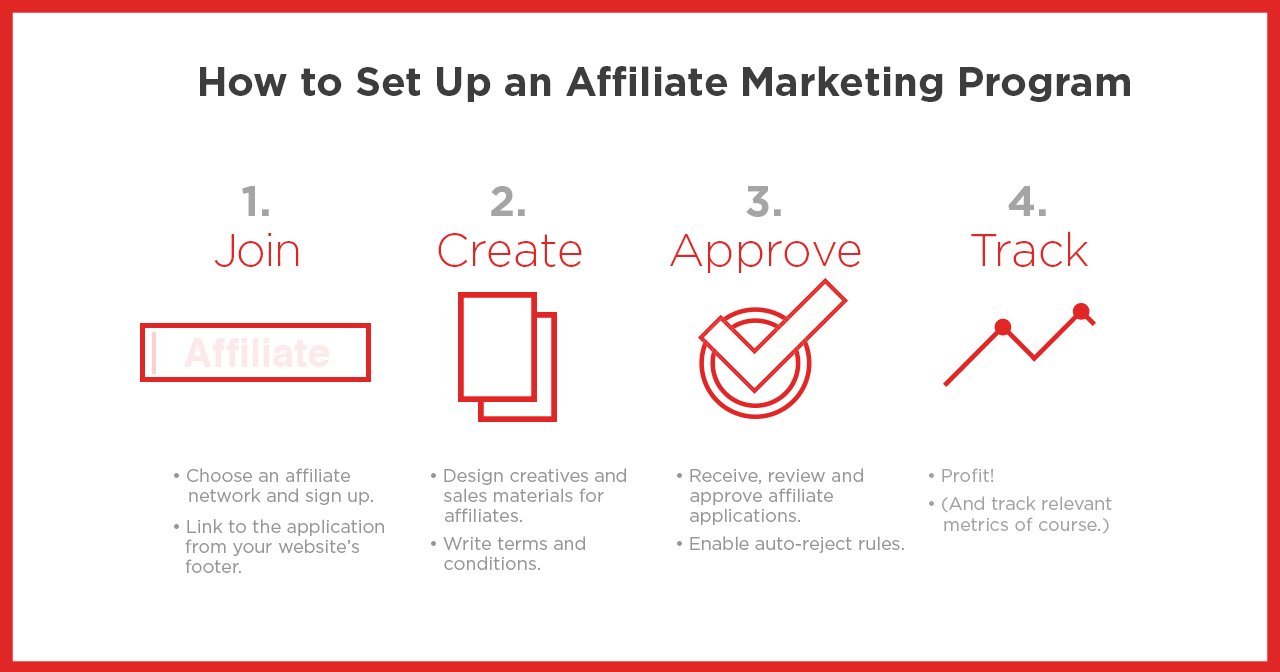Affiliate marketing can be an extremely cost-effective way to boost conversions by tapping into a previously undiscovered stream of warm leads, but is it a good strategy for your business?
What Is Affiliate Marketing?
Affiliate marketing — sometimes called performance marketing — essentially means hiring people to bring you customers, and only having to pay them when a conversion happens. For example, you might get a $100 sale on your e-commerce website, and the affiliate may get $5 of that. To get an idea of the power of affiliate marketing, check out these stats:
- Affiliates reportedly account for more than half of Amazon’s annual sales.
- The global affiliate marketing spend is expected to hit nearly $16 billion by 2024 — with spending on affiliate marketing in the United States alone predicted to grow to nearly $10 billion in the same time.
- More than eight in 10 brands worldwide employ some sort of affiliate-marketing program.
- Affiliate marketing accounts for nearly 20% of e-commerce sales globally.
- Easily accessible to online retailers, the ShareASale affiliate network boasts more than 270,000 active affiliate partners worldwide.
How Does Affiliate Marketing Work?
- Create your own in-house affiliate program manually, or use a popular affiliate network like CJ Affiliate, Rakuten Advertising (formerly Rakuten LinkShare) or ShareASale. These networks connect businesses (called advertisers or merchants) and affiliates (called publishers) who want to earn commissions by promoting products.
- Solicit, review and approve affiliate applications. Affiliate networks have tools for auto-approval (or auto-rejection) based on certain criteria, or you can manually vet each applicant.
- Approved affiliates promote your products or services on their websites, blogs, social channels, etc. and link to a page on your website using their uniquely tagged affiliate link URL.
- If a sale is made, the affiliate is paid the predetermined commission on that sale, which all happens automatically when you use a network.
This infographic offers more details on how to run an affiliate marketing program:

Why Use Affiliate Marketing?
1. Cost-Effectiveness
Affiliate marketing is among the most cost-effective forms of advertising, since you’re only paying for results. Once you figure out ongoing operating costs, it is fundamentally impossible for your affiliate program to operate at a loss because you know your cost per acquisition from the start.
2. Sales
An affiliate program allows you to tap into potential sources of traffic and revenue that you would otherwise not be getting. This is especially true of physical products, for which affiliates can do product review blog posts or videos, for example.
3. Brand Awareness
Not only can affiliates drive sales for you, but they can also boost brand awareness simply by reaching a larger audience and increasing your traffic and exposure. Even if visitors don’t buy anything, they may sign up for your newsletter — that means you’re growing your email list for free and can potentially get a sale by marketing to those visitors in the future. You can even drive offline conversions via something like an in-store voucher through the affiliate program, or you can drive consumers to offline retailers if you don’t sell direct.
4. SEO Value
Publishers (the affiliates) link to your website to send traffic your way. Provided they aren’t spammy, these links are usually beneficial for your off-page SEO efforts, since inbound links are a huge factor in Google’s ranking algorithm.
5. The “Industry” Is Growing
As previously mentioned, U.S. affiliate marketing spend is expected to grow to nearly $10 billion by 2024, fueled largely by the enormous growth of e-commerce and social media.
6. Customer Data
Using an affiliate program provides you with valuable data and insight into how, where and why your customers are buying, which you can then use to make smarter marketing decisions in the future across other channels.
Sounds like a no-brainer, right? Obviously, you want to jump in immediately and add affiliate marketing to your online sales arsenal.
But hold your horses.
There are a few reasons why you may not want to do that …
1. Time
The initial setup and implementation of a successful, fully developed affiliate program takes some time. Similarly, huge results from affiliate marketing do not happen overnight; it is a long-term investment. Thinking it’s a one-time, set-and-forget strategy is the wrong approach. Affiliate marketing can provide massive results, but only if you’re willing to put in the time.
2. Cost
Beyond your time and patience, affiliate marketing implementation requires resources. Having a fully developed program dictates that you design creative and sales materials to provide to your affiliates, write guidelines and tip sheets, help those who may be less tech-savvy, and alert affiliates to new products and promotions, etc. Once your program grows, you’ll also probably find it necessary to hire an actual program manager to run it. This, of course, doesn’t include the cost of commission to both the network/platform and the affiliates, which needs to be high enough to incentivize publishers to sign up for your program and promote your products.
3. Loss of Control
In a sense, you lose some control of your product and your brand when you take on affiliates. They will promote in different ways that may not necessarily fit your brand’s image or values. (However, don’t be too concerned about this — you’ll be able to set the ground rules when you sign new affiliates up. There’s more on that below.) A blogger may feature your brand alongside four others. It may be hard to monitor and control what affiliates are doing at all times, especially for a larger program.
It’s important that you establish thorough guidelines and rules for your program from the start, such as linking protocols, whether or not to let affiliates bid on your brand terms in PPC ads, and not allowing affiliates to create websites and content that mimic your own. Without strict guidelines and legal terms and conditions, advertisers can potentially be held liable for the actions of their affiliates, especially when proper disclosures aren’t in place. More on that below, too.
Affiliate Marketing vs. “Influencer Marketing”
There are some key differences between affiliate marketing and the newer world of so-called “influencer marketing” with “brand ambassadors.” Influencer marketing, born with the rise of social media, refers to finding and reaching out to individuals you deem to be “influencers” in your space — bloggers, vloggers, journalists, experts, etc. — who have a strong online presence in your target market and who fit your brand well. By partnering with influencers, brands hope to increase exposure and subsequent sales via the influencers’ followers.
First, let’s discuss post-implementation cost. As you now know, an affiliate only gets paid when a conversion occurs, e.g., earning a commission on a sale on an e-commerce website. Influencers, however, are usually paid a flat monthly fee to promote the brand, often by using free merchandise from the advertiser, with no guarantees of performance. This can be a huge risk for advertisers who may see no return on their influencer investment, whereas performance-based affiliate marketing is considered to be very low-risk.
Then, there’s tracking to consider. From the advertiser’s perspective, it can be hard to measure meaningful analytics from influencer marketing. You’re mostly relying on referral traffic statistics to arrive at some sort of useful interpretation of whether or not that particular influencer has grown the awareness of your brand. It’s almost necessary to have full access to the influencer’s own analytics for their publishing platforms.
On the other hand, affiliate marketing provides a more robust framework for tracking, measuring and drawing reliable conclusions about ROI, since affiliates use unique tracking IDs appended to their affiliate link URLs when driving traffic to your site. You could, for example, compare conversion rate and average order value between affiliate traffic and organic search traffic, or see which affiliate is responsible for the most conversions. (Sometimes, a handful of “super affiliates” can be responsible for substantial portions of the entire program’s conversions.) Of course, you can use both forms simultaneously. Influencers are generally used more for brand awareness strategy, whereas affiliates primarily drive new sales. Get the best of both worlds by using them together.
Don’t forget about FTC regulations! The government agency cracks down on brands that don’t enforce disclosure of an incentive-driven relationship between the advertiser and the publisher. This applies to influencers and affiliates, and in the past it has been fairly common for neither group to disclose the proper information. However, influencers seem to be even less aware of the rules than affiliates. In these situations, the advertiser, not the influencer or affiliate, incurs the wrath of the FTC in the form of penalties, fines and bad press. One need only look at the Lord & Taylor fiasco from back in 2015 to see that this can indeed be a serious issue. The FTC charged that the brand “deceived consumers by paying for native advertisements … and Instagram pictures.”
Google also began to suggest that publishers should be “nofollow”-ing links to advertisers, or else the publisher’s site could get hit with a Google penalty. This can all be avoided by establishing clear guidelines, staying up to date with FTC disclosure laws (and vehemently enforcing those disclosures), and prohibiting misrepresentation of your endorsements.
Is an affiliate program right for your business? Only you can decide. Break out the ol’ pro/con list. One of the easiest ways for you to determine whether or not it’s a good idea is by checking to see if any of your competitors have one and seeing what commission they’re offering. Simply look for a link in their website’s footer that says something like “Affiliates” or “Become an Affiliate.”
Seeking even more advice on whether or not affiliate marketing is right for your business? Or want to know more about how to promote affiliate programs? You’re in the right spot. Contact us today to learn more about affiliate and influencer marketing.
